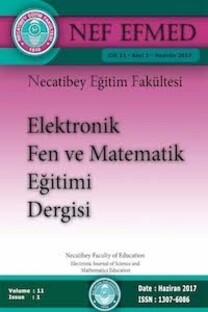Formal İspatın Mevcut Olmadığı Bir Durumda İspat İmajı Var Olabilir Mi?: Başarısız Bir İspat Girişiminin Analizi
İspat İmajı, İspat, cebir, matematik eğitimi
Can the Proof Image Exist in the Absence of the Formal Proof?: Analyses of an Unsuccessful Proving Attempt
Proof image, proof, algebra, mathematics education,
___
- Antonini, S., & Mariotti, M. A. (2008). Indirect proof: what is specific to this way of proving? ZDM, 40(3), 401-412.
- Barnard, A. D. & Tall, D. O. (1997). Cognitive Units, Connections, and Mathematical Proof. In E. Pehkonen, (Ed.), Proceedings of the 21st Annual Conference for the Psychology of Mathematics Education, Vol. 2 (pp. 41–48). Lahti, Finland.
- Bikner-Ahsbahs, A. (2004). Towards the Emergence of Constructing Mathematical Meanings, Proceedings of the 28th Conference of the International Group for the Psychology of Mathematics Education, Volume 2, 119-126.
- Clore, G. L. (1992). Cognitive phenomenology: Feelings and the construction of judgment. The construction of social judgments, 10, 133-163.
- Davydov, V. V. (1990). Soviet studies in mathematics education: Vol. 2. Types of generalization in instruction: Logical and psychological problems in the structuring of school curricula (J. Kilpatrick, Ed., & J. Teller, Trans.). Reston, VA, USA: National Council of Teachers of Mathematics. (Original work published in 1972.)
- Dictionary, O. E. (1989). Oxford English Dictionary. Simpson, JA & Weiner, ESC.
- Fischbein, E. (1982). Intuition and proof. For the learning of mathematics, 3(2), 9-24.
- Fischbein, E. (1999). Intuitions and schemata in mathematical reasoning. Educational studies in mathematics, 38(1-3), 11-50.
- Fischbein, H. (1987). Intuition in science and mathematics: An educational approach (Vol. 5). Springer Science & Business Media.
- Freudenthal, H. (1991). Revisiting mathematics education. Dordrecht, The Netherlands: Kluwer.
- Goldin, G. A. (2000). Affective pathways and representation in mathematical problem solving. Mathematical thinking and learning, 2(3), 209-219.
- Grootenboer, P., & Marshman, M. (Eds.). (2016). The Affective Domain, Mathematics, and Mathematics Education. In Mathematics, Affect and Learning (pp. 13-33). Singapore: Springer
- Hannula, M., Evans, J., Philippou, G., & Zan, R. (2004). Affect in mathematics education–exploring theoretical frameworks. In M. J. Hoines & A. B. Fuglestad (Eds.), Proceedings of the 28th Conference of the International Group for the Psychology of Mathematics Education (Vol. 1, pp. 107-136). Bergen, Norway: PME.
- Hershkowitz, R., Schwarz, B. B., & Dreyfus, T. (2001). Abstraction in context: Epistemic actions. Journal for Research in Mathematics Education, 32 (2), 195-222.
- Kidron, I. & Dreyfus, T. (2014). Proof image. Educational Studies in Mathematics, 87(3), 297-321.
- Kidron, I., & Dreyfus, T. (2010). Justification enlightenment and combining constructions of knowledge. Educational Studies in Mathematics, 74, 75-93.
- Knapp, J. (2005). Learning to prove in order to prove to learn. Retrieved on 6-June-2020 at http://mathpost.asu.edu/~sjgm/issues/2005_spring/SJGM_knapp.pdf
- Liljedahl, P. (2004). the AHA! Experience: mathematical contexts, pedagogical implications (Unpublished Doctoral Dissertation). Simon Fraser University, Burnaby. British Columbia, Canada.
- Liljedahl, P. G. (2005). Mathematical discovery and affect: The effect of AHA! experiences on undergraduate mathematics students. International Journal of Mathematical Education in Science and Technology, 36, 219–235.
- Moore, R. C. (1994). Making the transition to formal proof. Educational Studies in Mathematics, 27(3), 249-266.
- Rota, G.-C. (1997). Indiscrete thoughts. Boston, MA: Birkhäuser.
- Schwarz, B., Dreyfus, T., Hadas, N., & Hershkowitz, R. (2004). Teacher guidance of knowledge construction. In M. J. Hoines, & A. B. Fuglesad (Eds.), Proceedings of the 28th Conference of the International Group for the Psychology of Mathematics Education: Vol. 4 (pp. 169–176). Bergen, Norway: PME.
- Selden, A., McKee, K., & Selden, J. (2010). Affect, behavioural schemas and the proving process. International Journal of Mathematical Education in Science and Technology, 41(2), 199-215.
- Treffers, A., & Goffree, F. (1985). Rational analysis of realistic mathematics education—TheWiskobas program. In L. Streefland (Ed.), Proceedings of the 9th conference of the International Group for the Psychology of Mathematics Education (Vol. 2, pp. 97–121). Utrecht, The Netherlands: OW&OC.
- Türnüklü, E., & Özcan, B. N. (2014). the Relationship Between Students' Construction of Geometric Knowledge Process Based on RBC Theory And van Hiele Geometric Thinking Levels: Case Study. Mustafa Kemal University Journal of Graduate School of Social Sciences, 11 (27), p. 295-316.
- van der Waerden, B. L. (1954). Einfall und Überlegung: Drei kleine Beiträge zur Psychologie des mathematischen Denkens [Idea and reflection: Three small contributions to the psychology of mathematical thinking]. Basel, Switzerland: Birkhäuser.
- Weber, K. (2001). Student difficulty in constructing proofs: The need for strategic knowledge. Educational studies in mathematics, 48(1), 101-119.
- Weber, K., & Alcock, L. (2004). Semantic and syntactic proof productions. Educational studies in mathematics, 56(2-3), 209-234.
- ISSN: 1307-6086
- Yayın Aralığı: 2
- Başlangıç: 2007
- Yayıncı: Balıkesir Üniv. Necatibey Eğitim Fak.
Erdoğan ÖZDEMİR, Sabri KOCAKÜLAH
Matematiksel Modelleme Etkinliklerine Dayalı Öğrenme Ortamının İncelenmesi
Zeynep ÇAVUŞ ERDEM, Ramazan GÜRBÜZ
Öğretmen Adaylarının Öğrenme Stillerinin Şematik Not Hazırlamalarına Etkisi
Ortaokul Matematik Öğretmen Adaylarının İspat Kavramlarının Fenomenografik Bir İncelemesi
Yasemin YILMAZ AKKURT, Selda YILDIRIM
